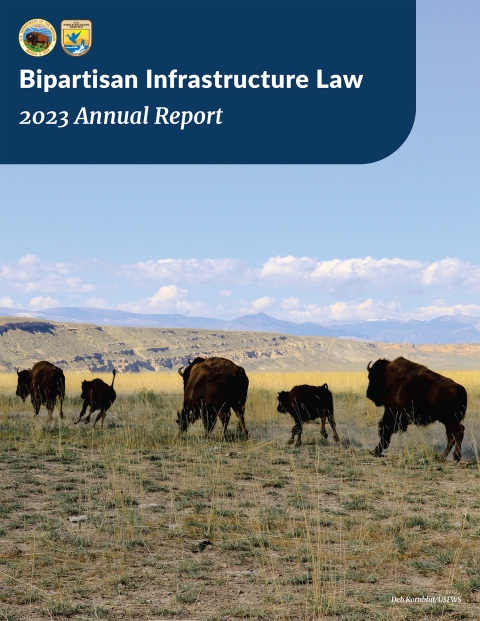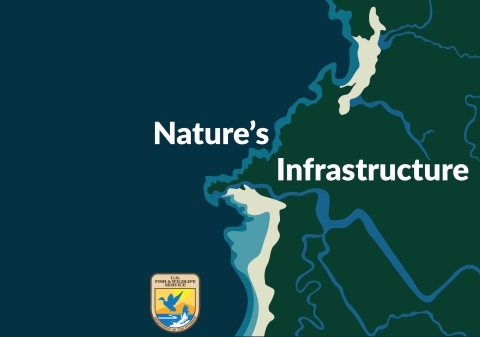USFWS: Infrastructure Law Benefitted Klamath, Tahoe Projects
The following is courtesy of the U.S. Fish and Wildlife Service:
President Biden signed the Bipartisan Infrastructure Law into law on November 15, 2021, providing the U.S. Fish and Wildlife Service with a five-year, $455 million transformational investment in our future. This historical funding is having positive impacts on people, local communities, and economies, and is providing critical resources for the Service to better support locally led conservation projects; improving public access; protecting people, infrastructure and wildlife habitats; and rebuilding the ecological infrastructure from the Klamath River to the Delaware Basin.

The Service’s success in meeting its mission is dependent on us leading with our values: stewardship, integrity, respect, collaboration, and innovation. Working collaboratively with communities and partners helps drive how we direct investments to achieve the greatest benefits for wildlife and communities. The projects supported by the Bipartisan Infrastructure Law are critical to helping communities withstand mounting environmental challenges and changes and ensuring the health and well-being of current and future generations.
In little more than two years, thanks to the Bipartisan Infrastructure Law, the Service has implemented funding for 18 projects in the Delaware River Basin, 40 in the Klamath Basin, and six in the Lake Tahoe area, which are supporting habitat restoration, invasive species control, and lasting solutions for healthy and functional ecosystems that benefit local communities, Tribes, agriculture, and a diversity of species.
The Delaware River Watershed is in one of the most densely populated urban areas in the nation, yet it remains 50% forested and boasts 400 miles of designated rivers within the National Wild and Scenic Rivers System. This watershed also provides drinking water to more than 15 million people and sustains habitats for a host of wildlife species from red knots and other shorebirds to iconic and economically valuable fish such as alewives, American shad, and eastern brook trout.
In the Lake Tahoe watershed, we are working alongside key partners, including the Tahoe Regional Planning Agency and the Washoe Tribe, who play a lead role in aquatic invasive species management through innovative removal methods, community engagement, and new aquatic invasive species prevention. In fact, aquatic invasive species management is a priority of the Lake Tahoe Environmental Improvement Program, one of the most comprehensive, collaborative restoration programs in the United States.

The Bipartisan Infrastructure Law also provides funding for 79 National Fish Passage Program projects across the country to remove barriers that are fragmenting rivers, blocking fish migration, and putting communities at higher risk for flooding. When complete, these projects are expected to remove 212 barriers and reopen roughly 6,200 stream miles, which will improve broader aquatic connectivity and help conserve vulnerable species.
We are also leading a multi-agency effort to coordinate the delivery of roughly $2 billion in Bipartisan Infrastructure Law funding for the restoration of fish passage and aquatic connectivity through the Federal Interagency Fish Passage Task Force.
Across the sagebrush country – the plains and mountains of western North America – we continue to use Bipartisan Infrastructure Law funding to work with federal and state agencies, Tribes, nongovernmental organizations, private landowners, and other partners to plan and deliver on-the-ground projects to conserve strategic habitat “cores” within the larger sagebrush ecosystem. These projects are underpinned by innovative science, including a landscape-scale conservation design that combats invasive grasses and wildfire, reduces encroaching conifers, and safeguards precious water resources. The outcomes of these vital investments will bolster ecological and community resilience to climate change and advance habitat conservation in this iconic American landscape.
Ecosystem Restoration is an important component for much of our work, and to date, the Bipartisan Infrastructure Law is funding 46 projects across the landscape that will lead to better outdoor spaces and habitats by advancing healthy forests, detecting and eradicating invasive species, investing in National Seed Strategy collection and production, restoring recreation sites and national parks, and mitigating hazards on mined lands. These projects are focused on furthering the Restoration and Resiliency Framework’s goals of restoring our lands and waters and advancing climate resilience.
The Bipartisan Infrastructure Law is providing capital to pay for plugging and reclaiming orphan well sites with the objective of eliminating environmental and public safety hazards stemming from leaking hydrocarbons, methane, and contaminated water. These derelict structures pose a threat to wildlife, their habitats, and nearby communities. In the last two years, the Service has established an inventory of orphan well sites across the National Wildlife Refuge System and is working with partners in Louisiana, Oklahoma, and West Virginia to create cooperative agreements for this work and provide technical oversight for the plugging and reclamation of orphan well sites on National Wildlife Refuges in these states.
Additionally, in Texas, the Bipartisan Infrastructure Law is providing funding for surface reclamation efforts on three National Wildlife Refuges for 30 sites where plugging operations are complete. These efforts will restore emergent wetland areas and protect habitats for sensitive nesting species and whooping cranes.
The Bipartisan Infrastructure Law also provides the Service with $180 million for maintaining, improving, and constructing roads, trails, and other transportation infrastructure and the Service receives additional Bipartisan Infrastructure Law funding through the Department of the Interior’s orphan well remediation, wildland fire, and ecosystem restoration programs.
While Bipartisan Infrastructure Law funding only spans a five-year period, investments and projects supported by the law will provide benefits far into the future to both people and wildlife.
As we embark on the third year of support under the Bipartisan Infrastructure Law, I am inspired by the positive, lasting impact these projects are making for communities across the country. With many groundbreaking and completion milestones happening soon, this is an exciting time for fish and wildlife conservation and for all of us. Through stewardship supported by the Bipartisan Infrastructure Law, we are investing in our shared future.



